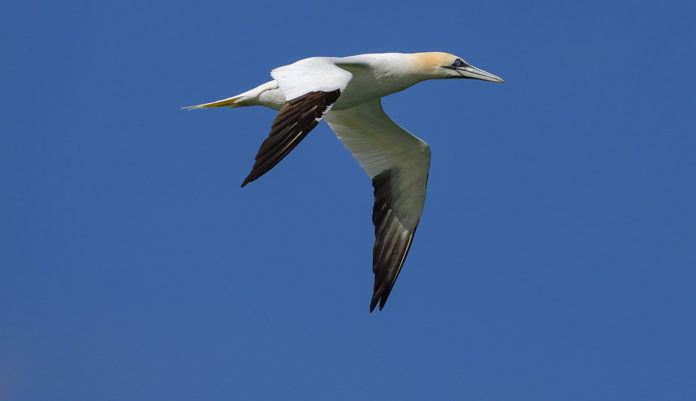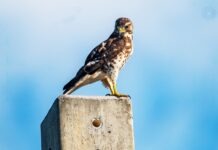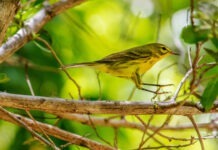The wind was up, so it was likely to be “sporty” crossing the Northwest Channel, but as I cleared the anchorage behind Wisteria Island and moved through the first set of channel markers, it was surprisingly calm. I kept waiting for waves to break over the bow and they didn’t.
About halfway to Mule Key, a low line of birds came towards me – big, white, fast-moving. I got a little excited, threw the engine into neutral, and felt the stern lift as the wake caught up to the boat.
The lead bird rose up over the water, and all the birds behind him rose, too, then he dropped down, and all the birds behind him also dropped, as if trying to illustrate a sine wave.
I felt confident in my abilities as I reached under the console and found my camera without even looking, throwing the strap over my shoulder, flicking on the power switch, and raising it to my eye. There was only darkness in the viewfinder, and I had the crystal clear memory of sliding the battery into the charger the night before and telling myself, “Remember to grab this in the morning.”
I counted 13 of them, all adult northern gannets, as they crossed in front of the bow and kept moving until they disappeared. I scrambled to find my dry bag and dig through it to find another battery.
A second line of gannets – nine of them this time – passed so close I could have leaned out and brushed their feathers as they passed.
I finally found a battery and loaded it, then sat there, bobbing on the waves, ready — for real this time — for a third line to cross.
Northern gannets are pelagic birds. If you’re not on the water or near the ocean’s edge, you’re not likely to see them.
But it wasn’t like I’d never seen northern gannets before. I’d once seen thousands of them during a single February weekend in Virginia. I have this incredibly vivid memory of speeding across the Chesapeake Bay Bridge-Tunnel, looking out the car window and seeing so many of them out over cold water that I wondered if it would be possible to calculate the number of gannets by cubic kilometer.
I’ve also seen northern gannets dozens of times traveling back and forth to the Dry Tortugas, though those birds are usually sitting in the water, two or three at a time, and mostly immatures.
My friend Carl used to talk about getting up early, going out to White Street Pier, setting up his scope, and watching good numbers of gannets pass, small shapes on the distant horizon. I’ve tried that myself, though I never manage to get there early enough or have the patience to stare at the empty ocean long enough.
Two things struck me about those birds in the channel. First, northern gannets are just stunning to see in flight, with plumage so white you can only think of formal wear or maybe bright snow on a clear morning, and a shape so tapered and sleek it brings to mind supersonic jets. The black pointed wingtips just add visual drama to the whole operation.
There’s a weightiness to gannets, a solidity to their flight that moves them through the air like a train down a track. They are large enough that people in olden times considered them short-neck geese.
It seems inelegant, at this point, to call them pointy-headed mouth breathers, but that’s exactly what they are. Their body mass and hollow bones mean they don’t sink well, so in order to feed and catch fish 60 feet below the surface, they dive from heights over 100 feet and hit the water at speeds up to 60 miles per hour. Their bodies have adapted by covering their nostrils with bone and keratin to keep water from shooting into their lungs, and by developing inflatable air sacs in the head and torso that help absorb the impact.
The second thing that struck me was the birds’ focus, intensity and organization. They weren’t just cruising around looking for fish. They weren’t whiling away the winter hours; it was a headlong effort, a mission. My suspicion is they were migrating, heading back to one of the six colonies in Canada where the New World’s population of northern gannets breed.
If you read the older accounts of the birds, ornithologists weren’t quite sure what they were doing around here. The book “Birdlife of Florida,” published in 1994, described the species as rare to uncommon in South Florida, and their movements and occasional summer presence in Florida as “puzzling,” and goes on trying to make sense of several decades worth of jumbled directional sightings and band recoveries.
It was the technology and the information they had at the time.
In the 2010s a group of Canadian scientists attached lightweight photosensitive geolocators to 40 birds to track them when they left their breeding colonies. A little more than a quarter of them flew from North Atlantic waters to overwinter in the Gulf of Mexico.
It’s a small sample size, and it would be dodgy business to extrapolate with confidence that we’re getting 25% of the 200,000 to 300,000 northern gannets that are estimated to live in the New World, either flying around or over Florida every winter. But it’s safe to say there are a lot more gannets in these parts than people think.
After those two sets passed me the other day, a third set never appeared. I eventually throttled up the boat and headed toward the Lakes, worried about all the birds I was missing as they flew behind me.
(Much appreciation to Richard Harlow Hattaway for this week’s photo of a northern gannet.)






















